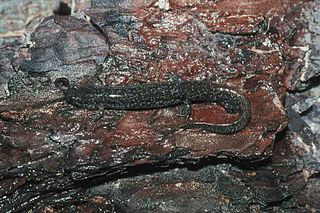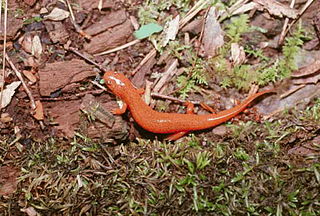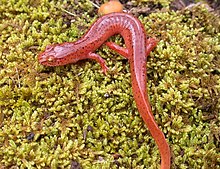
Desmognathus is a genus of lungless salamanders in the family Plethodontidae known as dusky salamanders. They range from Texas to the eastern United States and to south-eastern Canada.

Bolitoglossa is a genus of lungless salamanders, also called mushroom-tongued salamanders, tropical climbing salamanders, or web-footed salamanders, in the family Plethodontidae. Their range is between northern Mexico through Central America to Colombia, Venezuela, Ecuador, Peru, northeastern Brazil, and central Bolivia. Neotropical salamanders of the Bolitoglossa make up the largest genus in the order Caudata, consisting of approximately one-fifth of all known species of salamanders. Adult salamanders range anywhere from 45mm to 200mm in length depending on their specific species. They are notorious for their ability to project their tongue at prey items, as indicated from their name. They are also known for their webbed feet, having significantly more webbing than any other species outside their genus with the exception of the cave-dwelling Mexican bolitoglossine Chiropterotriton magnipes. Although webbed feet are a common characteristic of these salamanders, only about half of the species in this genus contain webbed feet.

Chiropterotriton, also known as splayfoot salamanders or flat-footed salamanders, is a genus of salamanders in the family Plethodontidae. The genus is endemic to Mexico.

Dendrotriton or bromeliad salamanders is a genus of salamanders in the family Plethodontidae, endemic to South and Central America: from Southwestern Chiapas, Mexico, to Honduras. These are lungless species possessing a slender body, long tail and prominent eyes. They inhabit high-elevation forests with high humidity.

The imitator salamander is a species of salamander in the family Plethodontidae. It is endemic to the Appalachian Mountains in the Eastern United States.

The Berry Cave salamander is a species of salamander in the family Plethodontidae, endemic to the Ridge-and-Valley Appalachians of eastern Tennessee in the United States. Its natural habitat is inland karsts where it lives underground. It is threatened by habitat loss.

The Tennessee cave salamander is a species of salamander in the family Plethodontidae, endemic to the Appalachian Mountains in the United States. Its natural habitats are streams in caves. It is threatened by habitat destruction.

The spring salamander is a species of salamander in the family Plethodontidae It is found in Canada and the United States. The generic name, Gyrinophilus, means "tadpole lover" and refers to the long period of time it spends as a gilled larva before maturing. The specific name, porphyriticus, is Latin from Greek, meaning the color of porphyry, a purple stone, and this salamander has also been called the purple salamander.
The West Virginia spring salamander is a species of salamander in the family Plethodontidae. It is endemic to West Virginia, the United States.

Hydromantes, commonly referred to as web-toed salamanders, is a genus of the lungless salamander family, Plethodontidae; they achieve respiration through their skin and the tissues lining their mouth. They are endemic to northern California, United States. Salamanders of this genus are distinguished in having extremely long tongues that they can project to 80% of their body length. Similar species endemic to southern France and Italy are now classified in a distinct genus, Speleomantes.

Nototriton, commonly referred to as moss salamanders is a genus in the salamander family Plethodontidae, which is characterized by their absence of lungs; they instead achieve respiration through their skin and the tissues lining their mouth. They range from Central Costa Rica to north-central and western Honduras reaching also to eastern Guatemala.
Pseudoeurycea is a genus of salamander in the family Plethodontidae. The members of this genus are commonly known as the false brook salamanders. They are found in Mexico and Guatemala.

Pseudotriton is a genus of salamanders in the family Plethodontidae. They are endemic to eastern and southern United States, from New York south to Florida and west to southern Ohio, Kentucky, Tennessee, and eastern Louisiana. They are commonly known as red salamanders or mud salamanders.
The many-lined salamander is a species of salamander in the family Plethodontidae. It is the only species of the monotypic genus Stereochilus. It is endemic to the United States.
Thorius arboreus, commonly known as the arboreal minute salamander, is a species of salamander in the family Plethodontidae. It is endemic to Sierra de Juarez, Oaxaca, Mexico. The specific name arboreus, derives from the Latin word arbor, meaning tree, referring to the arboreal habitat of this species.
Thorius, also known as minute salamanders, pigmy salamanders, or Mexican pigmy salamanders, is a genus of salamanders in the family Plethodontidae. They are endemic to Mexico and found in southern Veracruz and Puebla to Guerrero and Oaxaca.
Thorius pennatulus is a species of salamander in the family Plethodontidae and one of the smallest tetrapods, with adults reaching a length of about 15 to 21 millimetres . It is endemic to the mountains of Veracruz, Mexico.
Aquiloeurycea is a genus of salamanders in the family Plethodontidae. They are endemic to Mexico. The genus corresponds to the former "Pseudoeurycea cephalica species group", which was established in order to preserve Ixalotriton and Bolitoglossa while avoiding paraphyly of Pseudoeurycea.
The northern pygmy salamander is a terrestrial species of salamander in the family Plethodontidae and genus Desmognathus. Along with the southern pygmy and the seepage salamander, these are some of the smallest salamander species in North America and can be found in higher elevations in the southern Appalachians.











